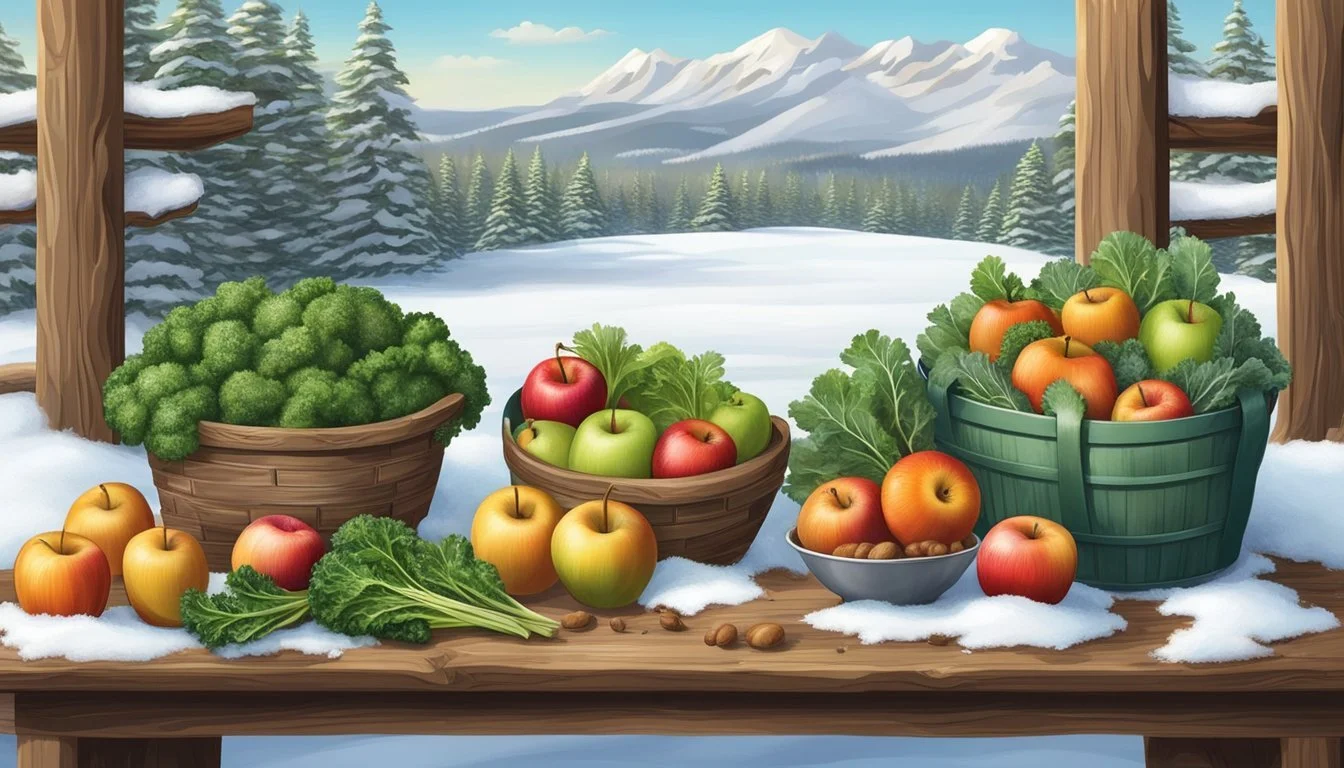Wisconsin Seasonal Fruit & Vegetables in January
Your Fresh Produce Guide
This Article is Part of our Wisconsin Seasonal Fruit & Veg Calendar
In the heart of winter, Wisconsin's agricultural landscape brings forth a selection of produce that can withstand the chilly temperatures. Although the state is widely recognized for its dairy products, with cheese and milk being prominent outputs, the winter months usher in a period where certain fruits (What wine goes well with fruit?) and vegetables come into season. Farmers' markets and local produce stands adapt their offerings, showcasing storage crops and hardy greens that have been harvested before the frost or grown in controlled environments.
Fruits are limited during this time, as the cold climate doesn't permit much cultivation outside of controlled settings such as greenhouses. Yet, despite the frigid weather, Wisconsin markets might still offer storage-friendly fruits like apples which have been harvested in the fall and kept in controlled conditions to prolong their freshness. Vegetables, on the other hand, embrace the winter with varieties such as kale, which can survive even when the temperatures drop, along with root vegetables like carrots (how long do carrots last?) and potatoes that are stored after fall harvests.
At this time, it is common for grocery stores and markets in Wisconsin to stock up on these resilient varieties, along with imported goods to ensure a diverse selection. While the winter may not be the most abundant season for fresh produce in Wisconsin, the state manages to provide its residents with a selection of fresh, seasonal vegetables that complement the hearty meals often enjoyed during the colder months.
Wisconsin's Seasonal Agriculture Overview
In January, Wisconsin's harsh winter climate necessitates specific agricultural adaptations. The state's farmers focus on hearty produce that can withstand the cold, emphasizing the importance of seasonal eating for freshness and nutritional value.
Winter Climate and Crop Adaptations
Wisconsin's winter weather, characterized by cold temperatures and heavy snowfall, significantly impacts local agriculture. Farmers predominantly turn to root vegetables and storage crops that thrive despite the short daylight hours and freezing conditions. Techniques such as cover cropping, hoop houses, and controlled storage environments are essential in extending the viability of these crops.
Importance of Seasonal Eating
Seasonal eating in Wisconsin during winter months not only supports local farms but also ensures that consumers receive fresh and nutritious food. Consuming local winter produce like root vegetables provides a tastier and potentially healthier option due to reduced transportation time and the retention of more vitamins and minerals.
Wisconsin's Key Winter Produce
The mainstay of Wisconsin's winter produce includes a variety of root vegetables such as beets, carrots, and potatoes. These crops, harvested in late fall, remain available due to their ability to be stored without significant loss of quality or taste. Other notable produce available in winter includes storage crops like squash and apples, as well as greenhouse-grown greens.
Wisconsin Winter Produce Availability Beets Storage Carrots Storage Potatoes Storage Squash Storage Apples Storage Greens Greenhouse
Growing Practices in Winter
During Wisconsin's winter, farmers leverage protective structures and indoor growing methods, such as heated greenhouses and cold frames, to continue producing certain vegetables and greens. These methods enable the extended growth of produce, thus improving its availability throughout the season and ensuring that farming can continue on a year-round basis.
January Fruit Options in Wisconsin
January presents a limited selection of fruits in Wisconsin. Due to the cold climate, residents often turn to stored or preserved fruits during this month.
Commonly Available Fruits
In Wisconsin, cranberries and apples are among the commonly available fruits in January. They are often sourced from local storage facilities or grocery stores. These fruits have been harvested during their peak season and are kept in controlled conditions to prolong their freshness.
Cranberries: Typically harvested in fall, they are still commonly available and can be found at local markets.
Apples: Stored from the previous autumn harvest, varieties like Honeycrisp and McIntosh remain accessible.
Storage and Preservation of Fruit
Fruits during Wisconsin’s winter are mostly available due to efficient storage and preservation techniques. Local farmers and distributors use methods such as controlled atmosphere storage to keep apples crisp and delicious throughout the colder months.
Refrigeration: Extends the life of apples and pears.
Canning: Cranberries are often canned to preserve their taste and nutritional value.
Importance of Local Fruit Consumption
Consuming local fruit like apples and cranberries supports the Wisconsin economy and ensures a lower carbon footprint compared to imported fruits. Local grocery stores and farmers' markets are the best places to find these fruits since they tend to stock products from nearby orchards and farms.
Economic support to local farmers.
Fresher produce with a better taste and nutrient profile.
Fruit Recipes and Preparation
Despite the limited variety, there are numerous recipes to enjoy Wisconsin fruits in January. Apples can be baked into pies or crisps, while cranberries make excellent sauces and dressings.
Apples: Ideal for pies, tarts, and ciders.
Cranberries: Perfect for cranberry sauce, compotes, or added to baked goods.
Local residents often make use of these fruits to create a host of warm, comfort food recipes that are perfect for the chilly weather. Cranberry apple crisps and pear apple crumbles are common dishes found on Wisconsin tables during January.
January Vegetable Harvest
In January, Wisconsin’s harsh weather limits the variety of local produce, yet certain vegetables thrive and are harvested during this cold month.
Available Root Vegetables
Root vegetables reign during the frosty Wisconsin January. They store well and maintain their flavor, making them a staple. Turnips, beets, and carrots are commonly available. They are versatile and can be roasted, mashed, or used in soups for a hearty winter meal. Parsnips, with their sweet, earthy taste, are also a seasonal favorite.
Turnips: Available and ideal for stews.
Carrots: Sweet and crunchy, perfect for both raw and cooked dishes.
Beets: Earthy flavor, great for roasting or pickling.
Parsnips: Add a sweet note to dishes when roasted or pureed.
Winter Squash and Hardy Greens
Winter squash, like butternut, is a January highlight with its sweet, nutty flavor and versatility in recipes. Butternut squash (how long does butternut squash last?) can be made into soups, purees, or even sweet desserts. Meanwhile, hardy greens such as kale and spinach withstand the cold and can provide a fresh, nutritional boost to meals.
Butternut Squash: Rich in taste, works well in both savory and sweet applications.
Kale: A robust green, suitable for salads, chips, or sautéed as a side.
Spinach: Tender and mild, ideal for salads or a quick sauté.
Cooking with Seasonal Vegetables
Cooking with January’s seasonal vegetables can be both nutritious and enjoyable. They enable chefs to get creative and serve warming, earthy dishes characteristic of winter cuisine. Recipes like roasted beet salads, creamy parsnip soup, and caramelized carrots are just a few ways to bring out the natural flavors of these vegetables. Utilizing combinations of these foods can yield dishes that are rich with the taste of the season and provide comforting sustenance during the cold Wisconsin winter.
Recipes: Incorporate roasted root vegetables or hearty greens for flavorful, seasonal dishes.
Taste: Seasonal vegetables offer a range of flavors from sweet to earthy.
Food: Utilizing January-harvested produce supports local agriculture and ensures a fresh, seasonal diet.
Indoor and Controlled Environment Growing
In January, Wisconsin's cold climate necessitates the use of indoor and controlled environments for growing fruits and vegetables. These methods allow for year-round production, providing fresh produce to local communities and supporting farms through community supported agriculture (CSA) programs.
Hydroponics and Greenhouses
Hydroponics is the practice of growing plants without soil, using mineral nutrient solutions in an aqueous solvent. In Wisconsin, hydroponics enables farmers to grow crops like lettuce, tomatoes, and herbs indoors, even during the harsh winter months. Greenhouses provide a controlled environment where heat and light can be regulated. They are essential for extending the growing season and protecting delicate plants from the extreme cold. Greenhouses can be found on many farms across the state, varying in size and technological sophistication.
Benefits:
Consistent year-round production
Reduced water usage compared to traditional farming methods
Potential for higher yields due to controlled conditions
Common Crops:
Lettuce
Tomatoes
Cucumbers
Strawberries
Community Supported Agriculture (CSA)
Community Supported Agriculture (CSA) programs connect consumers directly with their local farms. Members buy shares of a farm's harvest in advance, and in return, they receive a regular supply of seasonal produce throughout the year, adapted to the regional climate and growing conditions. This direct farm-to-table approach fosters a relationship between consumer and farmer, encouraging local production and consumption.
CSA Advantages:
Support Local Farms: Encourages sustainable agricultural practices and bolsters the local economy.
Freshness and Nutrition: Offers access to fresh, nutrient-rich produce.
Typical CSA Winter Offerings:
Root vegetables such as carrots and beets, stored from the fall harvest
Green leafy vegetables grown in greenhouses or indoor hydroponic systems
Preserved goods made from the previous season's produce, such as jams and pickles
Nutritional and Economic Aspects
January in Wisconsin brings a heightened awareness of the nutritional and economic benefits tied to seasonal fruits and vegetables. This section explores the health advantages of seasonal produce, the impact on the local economy, and the environment.
Health Benefits of Seasonal Produce
Consuming seasonal fruits and vegetables during their peak availability in Wisconsin ensures one receives the highest nutritional value. These fresh products contain vitamins, minerals, and antioxidants essential for good health. For instance, during winter, stored root vegetables and preserved items, such as apples and pears, offer necessary dietary fiber and vitamin C.
Supporting Local Economy and Farms
Purchasing seasonal produce directly benefits Wisconsin's economy. It bolsters local farms, reducing transportation costs and supporting the state's agricultural sector. Markets filled with state-grown produce keep the economic cycle vibrant, creating jobs and sustaining farm operations through direct community engagement.
Seasonal Eating and Sustainability
Engaging in seasonal eating aligns with sustainability practices. It generally involves a lower environmental impact due to reduced transportation distances and the corresponding decline in greenhouse gas emissions. Seasonal eating in Wisconsin during January embraces storage crops and preserves, highlighting how individuals can contribute to environmental health while enjoying produce with a lower carbon footprint.
Resources for Wisconsin Seasonal Eaters
Wisconsin residents seeking fresh, seasonal produce during the cold January months have a wealth of resources at their disposal. From detailed produce calendars to vibrant online communities, the options for staying in touch with local food sources are plentiful and informative.
Guides and Calendars for Seasonal Produce
Guides and calendars are essential tools for anyone wanting to consume seasonally in Wisconsin. They provide information on crop availability and harvest times, which can vary due to local climate conditions. The University of Wisconsin Extension offers comprehensive seasonal availability charts, which list year-round produce items such as meats, poultry, cheese, eggs, and preserved goods. For those specifically looking for fruits and vegetables, these guides also indicate which items are stored from previous seasons.
Finding Local Farmers Markets
Locating a local farmers market during January may be challenging, given the harsh Wisconsin winters. However, certain markets operate year-round, providing access to stored root vegetables, greenhouse-grown items, and other local products. A reliable resource for finding these markets is the Wisconsin Department of Agriculture, Trade and Consumer Protection. They maintain a database of registered farmers markets that can be sorted by location and operating seasons.
Online Communities and Social Media
Social media platforms like Facebook, Twitter, and Pinterest are rich with online communities centered on Wisconsin seasonal and local food. Users can join groups specific to their region where members share updates on farmers market schedules, tips for seasonal eating, and even swap recipes. These groups are not only a source of information but also offer support and community engagement for those passionate about supporting local agriculture throughout the seasons.







